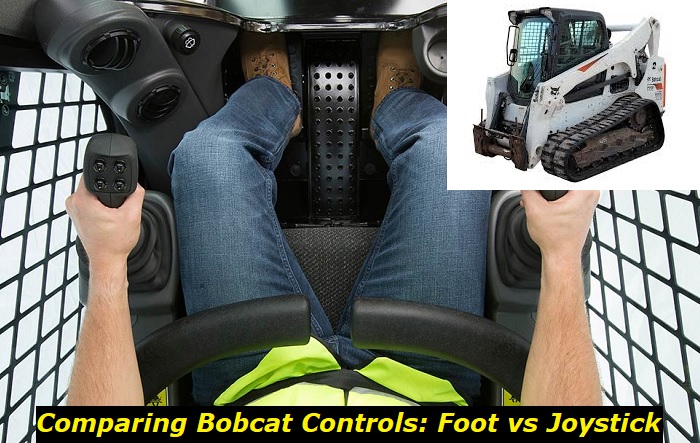Bobcat Foot Control vs Joystick – Which Way Is Better?
Operating and controlling Bobcat skid steers and other Bobcat special machinery varies from one machine to the other. However, all these pieces of machinery, despite being slightly different, have basic operating principles that any operator should be armed with.
The operational procedures of Bobcats depend on the tasks being performed and the attachments that are applied for each of the different task applications. With this in mind, Bobcat operations are either foot-controlled or joystick-controlled. In this article, we shall differentiate between foot control and joystick control, and then look at which of the two methods is better.

Older models of Bobcats came with a hand and foot control system as standard. However, today, most Bobcats come with optional foot control or joystick control as standard and the operator skills, as well as individual applications, determine which control to use. Despite these two options, operator skills are the key to the successful operation of the Bobcats.
Differences: Mechanical versus Joysticks
Most skid-steers, including Bobcat, use mechanical controls consisting of foot pedals and hand levers for most if not all functions. In this case, the further the pedal or lever moves, the faster the operation. Bobcat skid-steers have two-foot pedals that control the lifting of arms and the movement of buckets.
- The left foot pedal raises or lowers the arm. A heel push on this pedal raises the arm while a toe push on the same lowers the skid-steer's arm.
- Pushing the right pedal with the heel tilts the bucket toward the back while the pressure lowers the bucket forward.
On the other hand, many Bobcats came with two-hand levers that control the skid-steer drive. Each hand lever controls the drive wheels on its side and is also used to move the Bobcat forwards or in reverse, as well as turn it in any preferred direction.
On the other hand, Bobcats are increasingly turning to the use of joysticks for operation controls. A joystick is a control device that inputs control mechanisms through a stick that is pivoted on a base. The stick is moved at different angles that then direct the movement of the specific device it controls.
A joystick uses an electronic switch that detects the angle and direction of the stick to effect an equal movement on the specific device being controlled. This detecting mechanism uses potentiometers and hall-effects to clinically move and control all the Bobcat operations.
The Bobcat joystick system uses low-pressure hydraulic control that drives spools or valves that direct hydraulic flow to the auxiliary attachments such as the arms and the buckets. This electro-hydraulic system has electronic boards that sense the joystick movement when moved by the operator. The signal is then transmitted to the control unit which controls the opening/closing of valves and spools that then direct the hydraulic flow to the intended apparatus. With such movement, the hydrostatic drive and the loader systems are effectively controlled by the joystick.
The use of electro-hydraulic systems allows the incorporation of different hydraulic functions that can be easily handled by the joystick. As such, a joystick control may have many functions including:
- Operating/controlling auxiliary attachments
- Raising and angling the arms
- Turning/tilting the buckets
- Driving the Bobcat wheels
- Bucket dumping
- Horn
The left-hand joystick controls the left-hand drives, and left-hand wheels, raising and lowering the loading arms. Likewise, the right-hand joystick controls the right-hand wheels and all other functions of the bucket, including curling and dumping.
The joystick system usually uses an H-patterned system to allow the movement of the joystick either as a left-hand or right-hand component.
Types of Joysticks
There are three main types of joysticks - thumb, finger, and hand grip. However, the basic operation principles are the same and the differences are only in the type of machinery the joystick is operating.
Hand-grip joysticks are mainly applied with heavy-duty machinery such as construction and agricultural machinery. they are also called industrial joysticks. It is the type of joystick found on Bobcat and other skid-steers. The hand grip joysticks are highly versatile, have wear-free sensors and control systems, and have integrated multiple controls and applications.
Which Way is Better?
Between the traditional foot and hand controls and the modern joystick, which is better? Debate is rife on which control system is better than the other. However, even as the debate between traditionalists and modern-era operators rages on, manufacturers of modern Bobcats (and other skid steers/heavy machinery) are putting the joystick control as standard. As such, even those who still prefer the mechanical foot/hand controls have to use the joystick (even if partly) in the daily operations of the Bobcat.
For many years, Bobcat skid steers have been operated through a system of hand levers and foot pedals. These controls are used to drive the machine and to operate all the auxiliary attachments of the skid steer.
The hand/foot pedals are connected to the hydrostatic pump via the swash plate. The pump manages and controls the hydraulic flow that drives the Bobcat as well as the valves that are used to operate all loader functions. The hand and foot controls operate as follows:
1) Standard Dual-Lever Foot Control- This is a dual lever control that drives the machine using the hand levers while the foot pedals are used in loading and lifting applications. It is manual/mechanical which has remained as standard for most skid steer operations.
2) The H-pattern Controls- this control operates basically as the dual lever highlighted above. The levers have hinged handles that are pulled or pushed away from the operator. The levers operate the bucket functions as follows:
- The left controls the boom operations when pulled or pushed away from the operator.
- The right lever is used to lift or dump the bucket when pushed away from or pulled toward the operator.
3) To improve the operations of the foot/hand lever control systems, Bobcats come with a switch system that enables the operator to toggle between the standard and the H-pattern operations. This is known as ACS- Advanced Control System where the operator can flip between the two modes.
One major advantage of mechanical controls is the ability to adjust throttle and loader functions commensurate with the load capacity. This is done through the push or pull functions which transmit the power being released for a specific function.
However, the major disadvantage of the hand/foot control levers is the propensity to tear and wear. The movement of mechanical points provides points that are prone to wear and require constant lubrication and adjustments/replacements to ensure effectiveness.
Joystick controls are easier to handle and operate. They have replaced the hand, foot, fingers, toes, and heel operations. They have also replaced myriad mechanical linkages with durable hydraulics and electrical systems.
Joysticks are different from mechanical hand and foot levers. They are either hydraulic or have a more advanced electric-over-hydraulic system. The left joystick is used to drive the skid steer while the left is used to operate and control the auxiliary functions.
Joysticks come either as ISO-rated control or SAE-rated control. The ISO (International Organization of Standardization) is a global manufacturing standard to ensure the best practice production of goods. On the other hand, the SAE (Society of Automotive Engineers) is a professional standard for automotive production. Additionally, joysticks come with attachment controls that are very popular with operators.
The key features that come along with the joystick include:
- Precise joysticks provide precision on the drives and steering functions and provide a reaction to slow operations, turning, and the start/stop functions.
- Speed management- the joystick manages speed requirements and speed precision in tight areas.
- Control Pattern Selection- the operator has the option to select the ISO standard or the H-pattern system depending on the operator's preference.
- Fingertip Switches- most of the functions are within the grip and the operator does not need to release the joystick. The operator can control the speed, blinkers, or the horn effectively with the joystick.
- The horsepower Management joystick manages the drive system by maximum power output for other operations without compromising the engine power.
- Steering Drift Compensation- The joystick adjusts operational surfaces to reduce steering/side drifts to allow for maximum output from the Bobcat skid-steer.
- Joysticks come with a foot pedal that the operator can use to increase engine speed as the operator's feet are free.
- Moreover, the selectable joystick control enables the operator to have precise machine control and speed management independent of the engine speed. This function optimizes the auxiliary performance of the Bobcat.
Joystick Advantages:
- Joysticks have improved comfort for the operator and have made operations much easier and more effective.
- It has reduced operator fatigue, minimized maintenance and repairs, and increased overall Bobcat productivity.
- They come with little maintenance if they have a sealed hydraulic system to prevent moisture and dirt contamination.
- Repairs can be done without removing the joystick unit.
From the above functionalities, it is clear that the joystick offers more functional capabilities and operator options compared to traditional hand and foot operations. The joystick provides flexibility with many optional features that improve the operational efficiency of the Bobcat.

Add comment